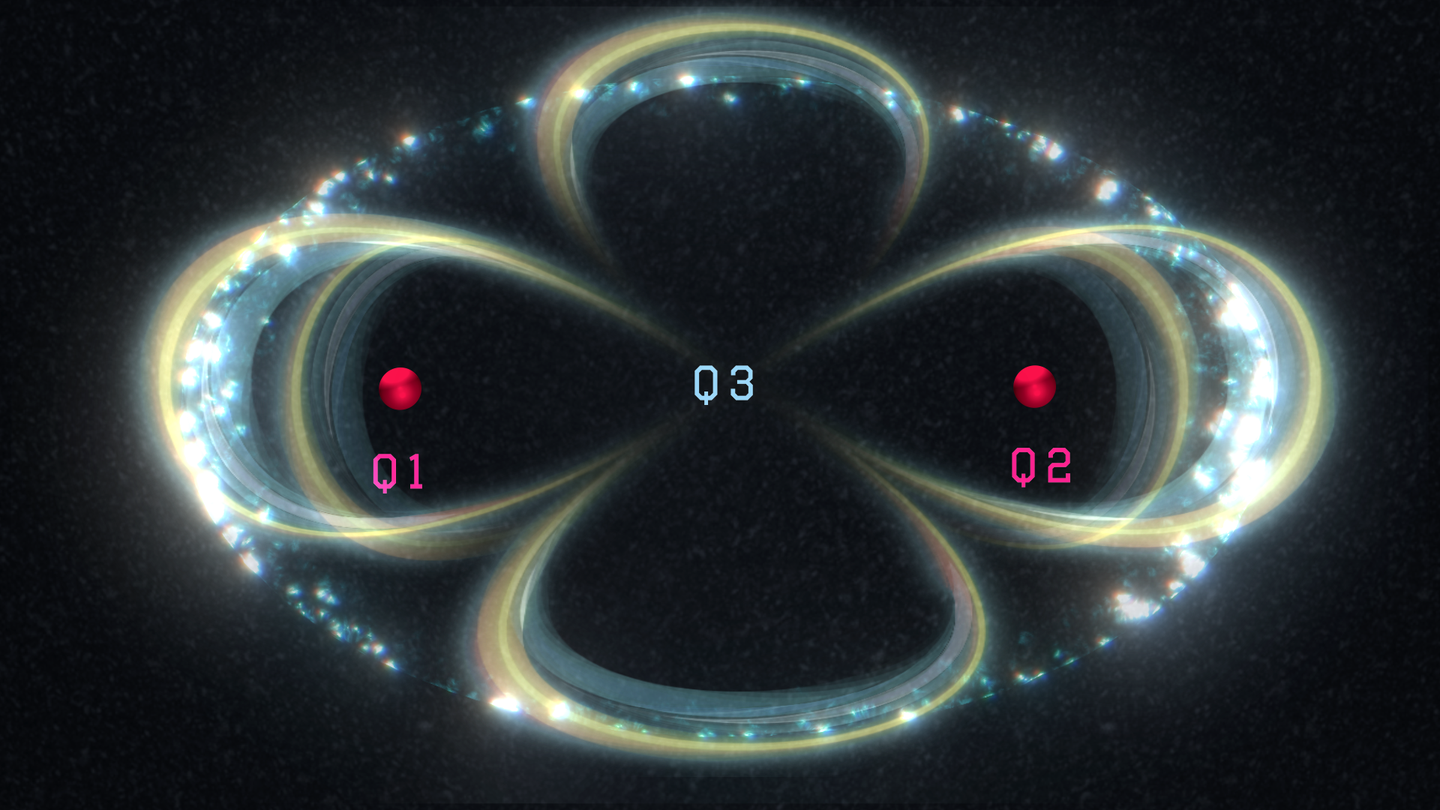Quantum computing in silicon hits 99% accuracy
UNSW Sydney-led research paves the way for large silicon-based quantum processors for real-world manufacturing and application.

[Jan 19, 2022: University of New South Wales]
A visualisation of UNSW’s three-qubit system, which can perform quantum logic operations with over 99% accuracy. (CREDIT: Tony Melov / UNSW)
Australian researchers have proven that near error-free quantum computing is possible, paving the way to build silicon-based quantum devices compatible with current semiconductor manufacturing technology.
“Today’s publication in Nature shows our operations were 99 per cent error-free,” says Professor Andrea Morello of UNSW, who led the work.
“When the errors are so rare, it becomes possible to detect them and correct them when they occur. This shows that it is possible to build quantum computers that have enough scale, and enough power, to handle meaningful computation.”
This piece of research is an important milestone on the journey that will get us there,” Prof. Morello says.
Morello’s paper is one of three published today in Nature that independently confirm that robust, reliable quantum computing in silicon is now a reality. This breakthrough features on the front cover of the journal.
Morello et al achieved 1-qubit operation fidelities up to 99.95 per cent, and 2-qubit fidelity of 99.37 per cent with a three-qubit system comprising an electron and two phosphorous atoms, introduced in silicon via ion implantation.
A Delft team in the Netherlands led by Lieven Vandersypen achieved 99.87 per cent 1-qubit and 99.65 per cent 2-qubit fidelities using electron spins in quantum dots formed in a stack of silicon and silicon-germanium alloy (Si/SiGe).
A RIKEN team in Japan led by Seigo Tarucha similarly achieved 99.84 per cent 1-qubit and 99.51 per cent 2-qubit fidelities in a two-electron system using Si/SiGe quantum dots.
Related Stories
The UNSW and Delft teams certified the performance of their quantum processors using a sophisticated method called gate set tomography, developed at Sandia National Laboratories in the U.S. and made openly available to the research community.
The UNSW team: Dr Asaad Serwan, Prof. Andrea Morello and Dr Mateusz Madzik. (CREDIT: UNSW/Kearon de Clouet)
Morello had previously demonstrated that he could preserve quantum information in silicon for 35 seconds, due to the extreme isolation of nuclear spins from their environment.
“In the quantum world, 35 seconds is an eternity,” says Prof. Morello. “To give a comparison, in the famous Google and IBM superconducting quantum computers the lifetime is about a hundred microseconds – nearly a million times shorter.”
But the trade-off was that isolating the qubits made it seemingly impossible for them to interact with each other, as necessary to perform actual computations.
Nuclear spins learn to interact accurately
Today’s paper describes how his team overcame this problem by using an electron encompassing two nuclei of phosphorus atoms.
“If you have two nuclei that are connected to the same electron, you can make them do a quantum operation,” says Dr Mateusz Mądzik, one of the lead experimental authors.
“While you don't operate the electron, those nuclei safely store their quantum information. But now you have the option of making them talk to each other via the electron, to realise universal quantum operations that can be adapted to any computational problem.”
“This really is an unlocking technology,” says Dr Serwan Asaad, another lead experimental author. “The nuclear spins are the core quantum processor. If you entangle them with the electron, then the electron can then be moved to another place and entangled with other qubit nuclei further afield, opening the way to making large arrays of qubits capable of robust and useful computations.”
David Jamieson, research leader at the University of Melbourne, adds: “The phosphorous atoms were introduced in the silicon chip using ion implantation, the same method used in all existing silicon computer chips. This ensures that our quantum breakthrough is compatible with the broader semiconductor industry.”
All existing computers deploy some form of error correction and data redundancy, but the laws of quantum physics pose severe restrictions on how the correction takes place in quantum computer. Prof. Morello explains: “You typically need error rates below 1 per cent, to apply quantum error correction protocols. Having now achieved this goal, we can start designing silicon quantum processors that scale up and operate reliably for useful calculations.”
For more science and technology news stories check out our New Discoveries section at The Brighter Side of News.
Note: Materials provided above by University of New South Wales. Content may be edited for style and length.
Like these kind of feel good stories? Get the Brighter Side of News' newsletter.
Tags: #New_Discoveries, #Global_Good_News, #Innovation, #Computers, #Quantum_Computing, #Qubits, #Research, #Science, #The_Brighter_Side_of_News
Joseph Shavit
Head Science News Writer | Communicating Innovation & Discovery
Based in Los Angeles, Joseph Shavit is an accomplished science journalist, head science news writer and co-founder at The Brighter Side of News, where he translates cutting-edge discoveries into compelling stories for a broad audience. With a strong background spanning science, business, product management, media leadership, and entrepreneurship, Joseph brings a unique perspective to science communication. His expertise allows him to uncover the intersection of technological advancements and market potential, shedding light on how groundbreaking research evolves into transformative products and industries.



